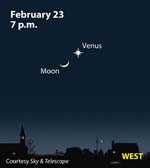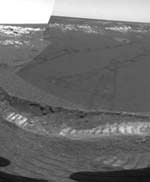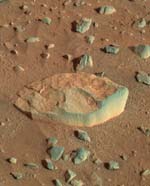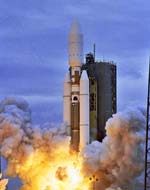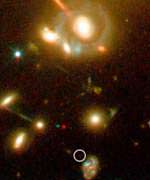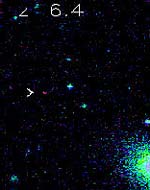
Image credit: NASA/JPL
The MER rovers Spirit and Opportunity, now traveling on the surface of Mars, are exploring a geography drier than the driest desert on Earth. Despite the polar ice caps and suspected pockets of liquid water beneath the martian surface, the amount of water on Mars is but a teaspoon compared to the vast watery reserves of Earth. Why is Mars so dry?
The inner planets of our solar system – Mars, Earth, Venus and Mercury – formed by the accumulation of small rocks and dust that swirled around the sun in its earliest years. If the Earth and Mars are made of the same stardust, they should have been born with about the same ratio of water.
Many scientists think Mars once was very watery, but lost its oceans due to the low mass of the planet. This, combined with a thin atmosphere, allowed most of the water on Mars to evaporate out into space.
But according to a study by Jonathan Lunine of the Lunar and Planetary Laboratory at the University of Arizona, the Red Planet was dry from the very beginning.
Lunine, writing in the journal Icarus in 2003 with colleagues John Chambers, Alessandro Morbidelli, and Laurie Leshin, says that Mars was originally a planetary embryo. In essence, a planetary embryo is a very large asteroid that can be as massive as Mercury or Mars. This pre-Mars embryo existed in the asteroid belt, which at the time was more widely dispersed in the solar system, spread out between 0.5 to 4 AU from the sun. Today the main asteroid belt is roughly at 2 to 4 AU, located between Mars (1.5 AU) and Jupiter (5.2 AU).
Lunine says that Mars grew to its present size from accumulations of smaller asteroids and comets. He says that the more massive Earth, in comparison, mostly formed from large planetary embryos colliding into each other.
“By chance Mars was not struck by giant asteroids while Earth was – the lucky versus unlucky pedestrian,” says Lunine. “But Mars was struck by much smaller bodies because these are so numerous.”
The Earth currently orbits the sun at 1 AU. Lunine says that planetary embryos in this orbit would not have had much water. Early in the sun’s evolution, during planetary formation, the dusty disk that surrounded the young star was very hot. Water-bearing compounds would not have been able to form in this disk at 1 AU.
Since Mars is further away from the sun than Earth, and closer to the cooler, “moist” regions of the asteroid belt, it would seem logical that Mars would have been born with more water. Yet Lunine says that Mars probably acquired only 6 to 27 percent of an Earth’s ocean (1 Earth ocean =1.5 ?1021 kg).
That’s because some of the planetary embryos that eventually constituted the Earth were saturated with water. While 90 percent of the embryos that formed the Earth were from the 1 AU region, and therefore dry, 10 percent were from 2.5 AU and beyond. Embryos coming from this distance would’ve had large supplies of water. Smaller asteroids coming from this distance would’ve contributed to the Earth’s water supply as well. At most, Lunine says that only 15 percent of Earth’s water came from comets.
Mars, meanwhile, had the bad luck to be born as a single dry rock. Mars eventually received some water late in the formation game, after its core had already formed and it had nearly reached its present mass. According to Lunine’s scenario, Jupiter also gained its present day mass around this time. Jupiter’s gravity then either sucked in nearby asteroids or caused them to scatter outwards. The proto-Mars somehow escaped being shifted by Jupiter’s gravity, but was bombarded by the outward-bound asteroids.
“The impacts of small asteroids and comets constituted a “late veneer” which added water to Mars, in contrast to the picture for Earth where water was added through collisions with Mercury-sized embryos throughout a growth period of some tens of millions of years,” the scientists write.
Although Mars doesn’t form in their computer model, the scientists think that may reflect the chaotic nature of planetary formation, where the directions of planetary embryos and asteroids are unpredictable and many outcomes are possible.
“There is a fair amount of randomness involved in building the terrestrial planets, so ending up with a Mars that did not happen to accrete many water-rich planetesimals is a possible occurrence,” says Alan Boss of the Carnegie Institution of Washington. “This may well help explain the paucity of water on modern-day Mars.”
Such differences in planetary formation also could occur among the inner planets of other solar systems. So far, astronomers know of 104 stars that have planets orbiting them. All of the extrasolar planets found so far are gas giants, but it seems likely that terrestrial planets like Mars and the Earth also could orbit distant stars, even though we do not yet have the technology to detect them.
If some inner terrestrial planets are formed by collisions of several planetary embryos, while others are embryos that only gather up moist comets and asteroids, then planets around these other stars could have very different amounts of water. Lunine suggests that the timing and formation of the gas giant planets in each solar system will play an important role in this process, just as Jupiter has influenced the character of our own solar system.
Lunine currently has a paper in Icarus, with Tom Quinn and Sean Raymond of the University of Washington, on the possible variation in water abundance for terrestrial planets around other stars. In addition, he is carefully watching the data collected by the MER rovers Spirit and Opportunity, as well as the satellites currently orbiting Mars.
“Odyssey, MER, and Mars Express will determine how much water exists at present, hopefully, and provide better constraints on past water abundance,” says Lunine. “I am particularly interested in the MARSIS radar results, and those of its successor – SHARAD.”
MARSIS is a radar device on the Mars Express satellite that can look through the top five kilometers of martian crust to search for layers of water and ice. The Italian space agency is planning to fly a shallow subsurface radar, called SHARAD, on NASA’s Mars Reconnaissance Orbiter to see if water ice is present at depths greater than one meter. While MARSIS has a higher penetration capability, it has much lower resolution than SHARAD will have.
Original Source: Astrobiology Magazine


